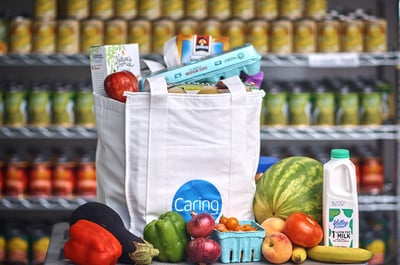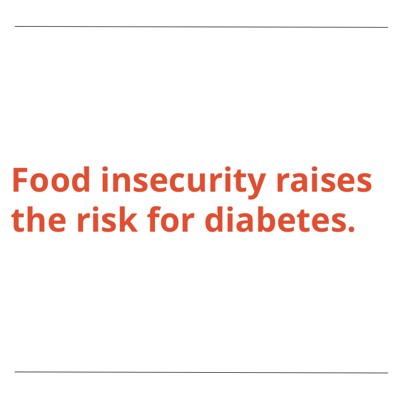Food as Medicine? When the Key to a Lower A1c is Access to Healthy Food
By Emily FittsKelly Close
 By Emily Fitts and Kelly Close
By Emily Fitts and Kelly Close
Geisinger’s Fresh Food Farmacy provides a “prescription” for healthy food to people with type 2 diabetes who are food insecure; plus, a Q&A with Geisinger
Medication is important, and so is exercise, but food is also a pillar of diabetes care. Many people, however, do not have consistent access to healthy food or even information about nutrition – this is often called “food insecurity.” In 2016, 12% of US households faced food insecurity according to the US Department of Agriculture (USDA). One in eight people who are food insecure in the US has diabetes, compared to one in ten people overall.
Public health officials have long advocated that low-income or otherwise "food insecure" people are provided both healthy food and education about food. This conversation isn't about food stamps, but rather about engaging with these individuals to fundamentally change their orientation around food, which is clearly important in type 2 diabetes. But such an effort would require a significant investment, and no one knows if the investment would pay off in better health outcomes and lower health care costs.
Geisinger is going to try to find out. This integrated health system that serves more than three million residents in Pennsylvania and New Jersey believes that “food is medicine." To that end, in 2016 it launched its Fresh Food Farmacy program, which identifies people who are food insecure and have type 2 diabetes with an A1c of greater than 8%. This program, which supports 250 people, provides fresh, healthy food and nutrition education.
Participants are given a “prescription” for healthy food, which includes enough food, menus, and recipes to prepare two meals a day for five days per week for themselves and their families. For a family of four, that’s enough food for 40 meals per week. The program also includes ongoing diabetes education and care from a team of clinicians and nutrition experts.
The initial results? A1c dropped by more than two percentage points: the average at the beginning of the program was 9.6%, which declined to 7.5% at the end of one year. In comparison, Geisinger’s CEO David Feinberg points out that in many trials, taking two diabetes medications is generally associated with a one-point drop in A1c levels.
The sample size is obviously small, and it is unclear whether this program is sustainable or scalable, but new approaches are welcome and necessary in improving diabetes management. To learn more about this program, diaTribe interviewed Dr. Andrea Feinberg, Medical Director of Health and Wellness at Geisinger, and Ms. Allison Hess, Associate Vice President of Health and Wellness at Geisinger.
diaTribe: How do you decide what is healthy food and what is not?
Ms. Hess: Food is selected and ordered by our Registered Dietician in line with diabetes (ADA) guidelines, and includes a variety of fresh fruits and vegetables, lean meats and whole grains. Although this is not a weight-loss program we teach portion control and healthy eating and many participants who are engaged and following meal plans do lose weight. Some have lost as much as 40 pounds and have requested a continued weight-loss program as part of their continued care plan.
 diaTribe: We love that in addition to the enrolled participant, family members also get access to the fresh, healthy food. Could you share more about what went into that decision?
diaTribe: We love that in addition to the enrolled participant, family members also get access to the fresh, healthy food. Could you share more about what went into that decision?
Dr. Feinberg: Those living under the same household share socioeconomic risks for food insecurity, and they are likely to share genetic risks for disease.
diaTribe: How long does a Fresh Food Farmacy prescription last?
Ms. Hess: Currently people can remain in the program as long as they are in need of food. We are still early on in the program but are planning to study sustainability of those who are no longer enrolled or graduate on their own.
diaTribe: What does patient education entail at the Fresh Food Farmacy, and how often can participants meet with their healthcare team?
Dr. Feinberg: It involves multiple aspects, including enrollment and engagement with a RN who coordinates a care plan with the participant’s PCP, one-on-one sessions with a dietitian for nutrition consultation, group diabetes self-management classes (15 hours worth), and health coaching plus weekly classes to address additional topics not covered elsewhere. Participants can meet with an educator once a week when they pick up food, and then more as needed.
diaTribe: What happens to people after they leave the program? Are the improvements in A1c sustained?
Ms. Hess: Since this program is relatively new, we have not had many individuals leave the program, so that data is still being reviewed.
diaTribe: That makes a lot of sense. What are the cost vs. benefits of this program? Specifically, how much do you anticipate this program could save on long-term health care system spending? What is the economic impact at the individual and family level (i.e., from factors such as cutting back on medications or hospital visits, etc.)?
Ms. Hess: We are already anecdotally seeing a very positive financial impact on the pilot patients. Medical literature estimates a cost savings of over $1,000 per person per month for one point reduction in A1c. We are seeing reductions of two points, on average, and some as great as five or six points with some of our patients. Those reductions have reduced the cost for medications, hospitalizations and complications. The savings will vary based on the level of illness the patient has; however, we are already seeing very positive clinical and financial impact.
diaTribe: That is so great to hear. What have been the biggest obstacles? 80% of the food comes from community food banks – is that always a reliable source?
Ms. Hess: Initial engagement has been the biggest obstacle. The food sources are very reliable and not a barrier.
diaTribe: We wish there were more ways to advance that first engagement. Can you talk a little bit about how you have you taken unique cultural needs of different communities into perspective with current participants? When the program expands, do you plan to tailor the nutrition plans to these unique cultural needs?
Ms. Hess: We want to make sure the recipes and food provided take into consideration the culture of the patients we are serving. That will likely vary based on the location of the Fresh Food Farmacy and the patients we are serving in that area. We will accommodate as needs are identified.
diaTribe: Right now, the program targets people with an A1c over 8%. Do you see this program expanding to help prevent people who have prediabetes from developing diabetes?
Ms. Hess: Yes, our goal is to expand into this area once we evaluate the clinical and financial impact of the current model.
diaTribe: We’d love to see this program grow and to see this kind of initiative taken up in other communities. Can you share a bit about your plans, as well as the biggest challenges in trying to scale this program?
Dr. Feinberg: We are planning on expanding to additional counties throughout Pennsylvania with Juniata and Mifflin Counties in fall 2018 and Lackawana Country in winter 2018. Regarding challenges, there are lots of them – engaging patients to participate is harder than we anticipated, although once in the program, participants love what we do for them.
 diaTribe: You mentioned engagement as a significant obstacle. What have you done to engage patients more?
diaTribe: You mentioned engagement as a significant obstacle. What have you done to engage patients more?
Dr. Feinberg: We have met with local medical clinics serving the North Umberland Community to share our experiences and explain Fresh Food Farmacy programming and benefits with primary care providers. This helps the clinical teams understand what we do, and they can then encourage and refer their eligible patients.
diaTribe: Do you have any advice for similar programs or insurance companies looking to implement something like the Fresh Food Farmacy successfully?
Dr. Feinberg: Food insecurity raises the risk for diabetes, so it is a natural approach to try to reduce diabetes by decreasing food insecurity. We would encourage others to look to address social determinants to improve health outcomes. Both the healthy food and engagement with the healthcare professionals is critical. Another thing to keep in mind is that a sudden change to healthy food in conjunction with current medications can drop blood sugar rapidly so if instituting a similar program be aware that hypoglycemia can be a side effect. Finally, we strongly encourage other health systems to use the three pillars of the program: education of the patient on their disease, assistance with social needs, and provision of food for the patient and the entire household.
diaTribe: What an inspiring program. Thank you so much for all you are doing for patients and the field of diabetes by providing this remarkable example.







